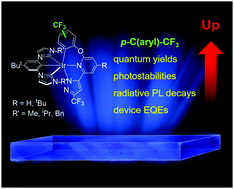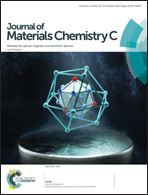Blue-emitting bis-tridentate Ir(iii) phosphors: OLED performances vs. substituent effects†
Abstract
A series of six Ir(III)-based blue-emitting bis-tridentate phosphors, for which a 6-pyrazoly-2-phenoxypyridine (pzyPx) chelate is functionalized with either a m- or p-CF3 substituent at the terminal phenoxy site, and a tert-butyl substituent at the 4-position of the central pyridyl group, while the substituent of a carbene pincer ancillary is varied from methyl, isopropyl and to benzyl, are strategically designed and synthesized. A majority of these blue phosphors exhibit a nearly unitary emission quantum yield (Φ) in degassed solution and enhanced stability against photo-degradation in degassed toluene solution comparable to that of green, sky-blue and true-blue emitters, i.e. fac-[Ir(ppy)3], FIrpic and mer-[Ir(pmp)3], under irradiation with a xenon lamp at a power density of 620 W m−2 and at 35 °C. Corresponding OLED devices are fabricated using these pzyPx functionalized Ir(III) phosphors co-doped in a 9-(3-(9H-carbazol-9-yl)phenyl)-9H-carbazole-3-carbonitrile (mCPCN) host material, giving a max. EQE in the range of 8.0–12.2% and stable CIEx,y coordinates between (0.16, 0.22) and (0.17, 0.27). Importantly, the max. EQE of these OLEDs is qualitatively proportional to the phosphorescence radiative lifetime recorded in either the solution state or the doped host matrix, showing a critical factor for the development of successive blue emitters.



 Please wait while we load your content...
Please wait while we load your content...